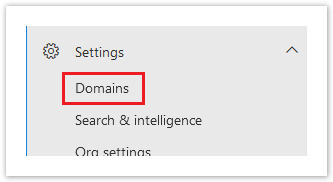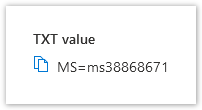- Created by Unknown User (jdougherty), last modified by John Dougherty on May 09, 2025
p-tdr
In This Article
Overview
In this article you will be adding your unique Teams Direct Routing domains to your 365 tenant. These routing domains are created and managed by XTIUM. Additionally, you will be creating a new user/service account for each of the routing domains.
Here's an example of the routing domains and user/service accounts. Do NOT add the below domains to your 365 tenant. You will receive your own unique domains from XTIUM.
| Location | Routing Domain* | User/Service Account UPN |
|---|---|---|
| XTIUM East | c1005437.phl01.us.teams.evolveip.net | xtm-tdr@c1005437.phl01.us.teams.evolveip.net |
| XTIUM West | c1005437.las01.us.teams.evolveip.net | xtm-tdr@c1005437.las01.us.teams.evolveip.net |
*Note: you will receive unique routing domains for your configuration from the XTIUM delivery team.
IMPORTANT
- Adding a domain to your 365 tenant requires the Domain Name Administrator role, or the Global Administrator role.
- Creating the user/service accounts for each of the routing domains requires the User Administrator role, or the Global Administrator role.
Adding Your Domains
After XTIUM has created your direct routing domains, perform the following steps to add each domain to your 365 tenant:
Sign into your Microsoft 365 Admin Center
In the left navigation pane, browse to: Settings > Domains
In the main window, click the + Add Domain button.


Enter or paste in your Teams direct routing domain, and click Use this Domain at the bottom of the page.
- Select Add a TXT record to the domain's DNS records, and click Continue at the bottom of the page.

Copy the TXT Value and/or take a screenshot of the information as shown below, and email the info to the XTIUM delivery team. The TXT Value needs to be added to your domain's DNS zone, which is done by XTIUM.
Once the TXT value has been added to your DNS zone by XTIUM, you can click the Verify button, which forces Microsoft to check for the DNS record.
To verify the domain later, click the Close button in the bottom-right corner of the page.

- After clicking Verify, the next page will ask you how you want to connect to your domain?
- Click More Options in the center of the page.
- Select the Skip and Do This Later radio button, and click Continue.
- Click Done.
- The domain status will read, No Services Selected, which is normal.

Add the User/Service Account
For each routing domain added to your 365 tenant, you need to create a user/service account using the domain, and temporarily assign it a 365 license that includes MS Teams (e.g. Office 365 E1).
- Sign into your Microsoft 365 Admin Center
- In the left navigation pane, browse to: Users > Active Users
- Click the button to Add a User
User/Service Account Details
| Item | Value |
|---|---|
| First Name | XTIUM Teams |
| Last Name | Direct Routing - East |
| Display Name | (DO NOT DELETE) XTIUM Teams Direct Routing - East or (DO NOT DELETE) XTIUM Teams Direct Routing - West |
| Username (UPN) | xtm-tdr @ your.direct.routing.domain.net [pick either the east (phl01) or west (las01) from the drop-down menu] |
| Password |
Notes:
|
| Location | If needed set the location to the United States. |
| Licenses | Select a 365 license that includes MS Teams (e.g. Office 365 E1) |
| Roles | User (no administration access) |
| Profile Info | None, unless you have organizational requirements to add profile info. |
spacer
| Item | Value |
|---|---|
| First Name | Evolve IP Teams |
| Last Name | Direct Routing - NNpeer01 |
| Display Name | (DO NOT DELETE) Evolve IP Teams Direct Routing - NNpeer01 |
| Username (UPN) | eip-tdr @ your.direct.routing.domain.net [pick either the NNpeer01 (AMS) or NNpeer02 (DFT) from the drop-down menu] |
| Password |
Notes:
|
| Location | If needed set the location to your country. |
| Licenses | Select a 365 license that includes MS Teams (e.g. Office 365 E1) |
| Roles | User (no administration access) |
| Profile Info | None, unless you have organizational requirements to add profile info. |
Verify the User/Service Account
After creating the user account, wait 10-15 minutes and then sign into the Microsoft Teams services using PowerShell.
Run the below command to verify the user account is enabled for MS Teams:
Get-CsOnlineUser xtm-tdr@your.direct.routing.domain.net | FL DisplayName, SipAddress, IsSipEnabled, TeamsUpgrade*
- A SIP Address should be present and include the domain.
- IsSipEnabled should equal True, which means the account is licensed for MS Teams.
- The Teams Upgrade Effective Mode should equal TeamsOnly
Example Output
DisplayName : (DO NOT DELETE) XTIUM Teams Direct Routing - East
SipAddress : sip:xtm-tdr@c1002345.phl01.us.teams.evolveip.net
IsSipEnabled : True
TeamsUpgradeEffectiveMode : TeamsOnly
TeamsUpgradeNotificationsEnabled : False
TeamsUpgradeOverridePolicy :
TeamsUpgradePolicy : UpgradeToTeams
TeamsUpgradePolicyIsReadOnly : ModeAndNotifications
If the Teams Upgrade Effective Mode is not set to TeamsOnly, run the following PowerShell command:
Grant-CsTeamsUpgradePolicy -Identity xtm-tdr@your.direct.routing.domain.net -PolicyName UpgradeToTeams
Next Steps
NOTE
Make sure you have added 2 routing domains to your tenant, and created 2 user/service accounts. If not, you're not ready to move onto the next steps.
We recommend that you wait about 30-60 minutes before continuing to the next steps. This allows Microsoft's back-end services to fully sync up with the new routing domains.